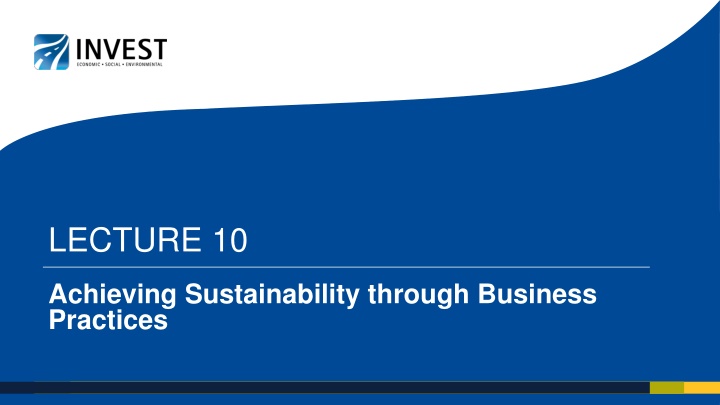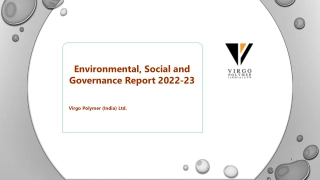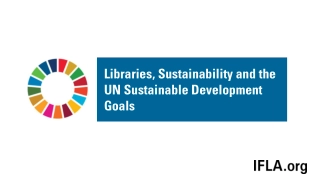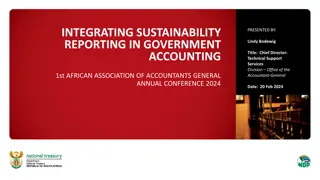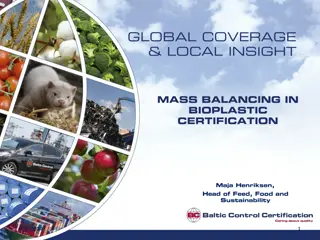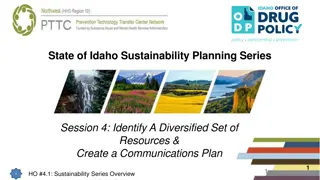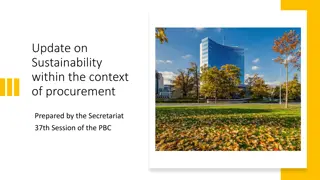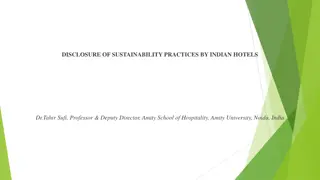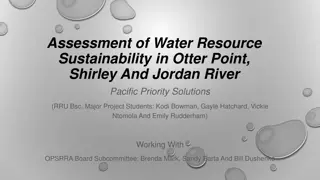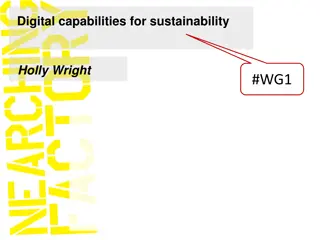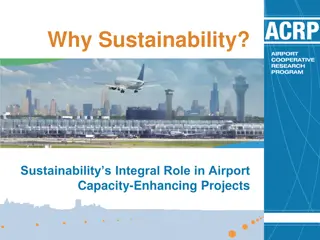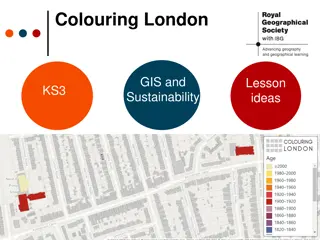Achieving Sustainability through Effective Business Practices
Emphasizing sustainable strategies in business operations boosts environmental and social responsibility. Learn how to integrate sustainability into daily practices, ensuring longevity and shared values with stakeholders. Explore innovative approaches to create a lasting impact on the environment while maintaining profitability and societal well-being. Gain insights into responsible resource management, ethical decision-making, and long-term competitiveness in today's dynamic market landscape.
Download Presentation

Please find below an Image/Link to download the presentation.
The content on the website is provided AS IS for your information and personal use only. It may not be sold, licensed, or shared on other websites without obtaining consent from the author.If you encounter any issues during the download, it is possible that the publisher has removed the file from their server.
You are allowed to download the files provided on this website for personal or commercial use, subject to the condition that they are used lawfully. All files are the property of their respective owners.
The content on the website is provided AS IS for your information and personal use only. It may not be sold, licensed, or shared on other websites without obtaining consent from the author.
E N D
Presentation Transcript
LECTURE 10 Achieving Sustainability through Business Practices
Contracting and Sustainability Contracting is the process of establishing a legally enforceable agreement expressing the expectations, responsibilities, and protections of each party for services and materials. 2
Contracting and Sustainability Contracts are a risk allocation instrument that identifies how the risk associated with sustainability goals and requirements is shared between the contract parties Specifically, contracts can: Allow, mandate, and incentivize sustainability Explain how sustainability is priced Describe how the risks associated with sustainability are allocated Source: S. Muench, G. Migliaccio, J. Kaminsky, M. Ashtiani, A. Mukherjee, C. Bhat, and J. Anderson. NCHRP Research Report 916: Sustainable Highway Construction Guidebook. 2019. https://doi.org/10.17226/25698 3
It is the least effective method to address sustainability because there is no guarantee that any SCP will occur Allowing Sustainability Typically, a contractor will only implement an allowed but not required SCP if it represents a business opportunity The passive contractual approach to sustainability is to allow certain sustainable construction practices (SCPs) but to require none If the SCP can increase revenue or market share, reduce expenses, increase employee productivity, or reduce risk Contractor wishes to implement an SCP for reasons of goodwill (done for the greater good of society) Source: S. Muench, G. Migliaccio, J. Kaminsky, M. Ashtiani, A. Mukherjee, C. Bhat, and J. Anderson. NCHRP Research Report 916: Sustainable Highway Construction Guidebook. 2019. https://doi.org/10.17226/25698 4
One way to require SCPs in a contract is to specifically call out each one in the contract and/or specifications as any other construction practice would be Requiring Sustainability Alternatively, a performance-based metric can be identified in the contract, allowing the contractor to meet it by choosing from a list of SCPs This provides contractors with the flexibility to meet sustainability requirement in the most cost-effective and efficient manner For example, including a requirement in the contract to use a particular accelerated bridge construction technique deemed most feasible for a particular project The aggressive contractual approach to sustainability is to require specific SCPs within the contract Source: S. Muench, G. Migliaccio, J. Kaminsky, M. Ashtiani, A. Mukherjee, C. Bhat, and J. Anderson. NCHRP Research Report 916: Sustainable Highway Construction Guidebook. 2019. https://doi.org/10.17226/25698 5
To incentivize inclusion Contractors must spend money to achieve an incentive, so incentives should not be viewed as entirely supplemental income/profit Incentivizing Sustainability There are associated expenses, which can be substantial The positive contractual approach to sustainability is to incentivize inclusion of SCPs in a project Incentivizing SCPs adds to the allowing sustainability approach by providing money to influence when the contractor might view accomplishing an SCP as a good business opportunity There is no guarantee that any identified SCP will be accomplished since it is at the contractor s discretion An example of incentivizing SCPs is a payment offered by an owner to a contractor if the contractor s project team has one or more personnel credentialed in the sustainability rating system being used on the project Source: S. Muench, G. Migliaccio, J. Kaminsky, M. Ashtiani, A. Mukherjee, C. Bhat, and J. Anderson. NCHRP Research Report 916: Sustainable Highway Construction Guidebook. 2019. https://doi.org/10.17226/25698 6
SCPs can be priced separately on a unit bid schedule When done, it is often because the owner wants to identify how much SCPs cost upfront (since sustainable practices, such as using materials with a lower carbon footprint based on an LCA, may be more expensive) Pricing Sustainability Source: S. Muench, G. Migliaccio, J. Kaminsky, M. Ashtiani, A. Mukherjee, C. Bhat, and J. Anderson. NCHRP Research Report 916: Sustainable Highway Construction Guidebook. 2019. https://doi.org/10.17226/25698 7
Pricing Sustainability (continued) If understanding the cost of sustainable practices is a goal, it can best be done by listing them separately as an alternate bid a defined portion of the work that is priced separately, which provides the owner an option to include that scope of work A baseline bid can be compared with a sustainable alternate bid Cost of sustainability is difficult to determine from a bid because: Bids indicate price, not cost Many SCPs have short or nonexistent histories, which may make an accurate estimate difficult Source: S. Muench, G. Migliaccio, J. Kaminsky, M. Ashtiani, A. Mukherjee, C. Bhat, and J. Anderson. NCHRP Research Report 916: Sustainable Highway Construction Guidebook. 2019. https://doi.org/10.17226/25698 8
Risks involved with SCPs may be less understood and quantifiable than more traditional risks: Which party assumes the risk if it does not function properly? What if it costs more than anticipated? What if it gets removed from the contract by change order but is needed to meet a rating certification required by the contract? Sustainability Risks Project delivery methods that make communication among parties easier, such as design-build (DB), are generally better suited to sustainable procurement and contracting Focusing on sustainability is relatively new, and more communication is needed to agree on processes and details that are newly developed Project delivery systems that emphasize sharing of project risks in a non-adversarial manner, such as systems based on DB, show an improved performance on project sustainability metrics Contracts determine risk allocation between parties Source: S. Muench, G. Migliaccio, J. Kaminsky, M. Ashtiani, A. Mukherjee, C. Bhat, and J. Anderson. NCHRP Research Report 916: Sustainable Highway Construction Guidebook. 2019. https://doi.org/10.17226/25698 9
Business Benefits of Sustainability 1. Drives internal innovation Sustainable practices provide the opportunity for new, innovative ideas to grow 2. Improves environmental and supply risk Renewable resources provide greater security over energy sources 3. Attracts and retains employees Commitment to sustainability may impact employees career decisions 4. Expands audience reach and builds brand loyalty Focus on sustainability may help build a broader, more loyal customer base 5. Reduces production costs Using fewer resources, or more sustainable ones, can decrease production costs 10 10
Business Benefits of Sustainability (continued) 6. Garners positive publicity Sustainability draws attention in the form of press releases and announcements 7. Helps you stand out in a competitive market Differentiation from competitors has market value 8. Sets the industry trend Organizations that are the first in their field to adopt sustainable practices become a trend-setting leader and prompt other organizations to follow https://online.hbs.edu/blog/post/business-case-for-sustainability 11 11
LECTURE 10 Achieving Sustainability through Business Practices
